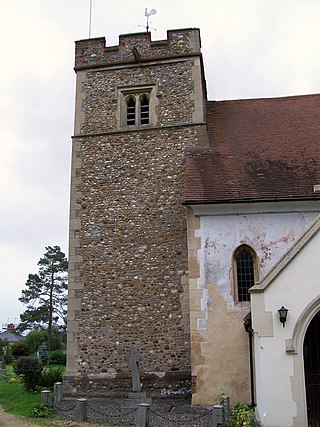Related Research Articles

Philip Doddridge D.D. was an English Nonconformist minister, educator, and hymnwriter.

Little Wymondley is a village and former civil parish situated between Hitchin and Stevenage, now in the parish of Wymondley, in the North Hertfordshire district, in the county of Hertfordshire, England. Paradoxically, it has a larger population than its near neighbour Great Wymondley. At the 2011 Census the population of the built-up area of Little Wymondley was 995. In 1931 the parish had a population of 445.

New College London (1850–1980) was founded as a Congregationalist college in 1850.

Joseph Edkins was a British Protestant missionary who spent 57 years in China, 30 of them in Beijing. As a Sinologue, he specialised in Chinese religions. He was also a linguist, a translator, and a philologist. Writing prolifically, he penned many books about the Chinese language and the Chinese religions especially Buddhism. In his China's Place in Philology (1871), he tries to show that the languages of Europe and Asia have a common origin by comparing the Chinese and Indo-European vocabulary.

John Conder D.D. was an Independent minister at Cambridge who later became President of the Independent College, Homerton in the parish of Hackney near London. John Conder was the theological tutor at Plaisterers' Hall Academy in 1754; and residential tutor and theological tutor at Mile End Academy, then the theological tutor at Homerton Academy.
Matthew Atmore Sherring (1826–1880), usually cited as M. A. Sherring, was a Anglican missionary in British India who was also an Indologist and wrote a number of works related to India. He was educated at Coward College, a dissenting academy in London that trained people for nonconformist ministry.

Wymondley is a civil parish in Hertfordshire, England.
The dissenting academies were schools, colleges and seminaries run by English Dissenters, that is, Protestants who did not conform to the Church of England. They formed a significant part of education in England from the mid-seventeenth to nineteenth centuries.

The New College at Hackney was a dissenting academy set up in Hackney in April 1786 by the social and political reformer Richard Price and others; Hackney at that time was a village on the outskirts of London, by Unitarians. It was in existence from 1786 to 1796. The writer William Hazlitt was among its pupils, sent aged 15 to prepare for the Unitarian ministry, and some of the best-known Dissenting intellectuals spent time on its staff.
Daventry Academy was a dissenting academy, that is, a school or college set up by English Dissenters. It moved to many locations, but was most associated with Daventry, where its most famous pupil was Joseph Priestley. It had a high reputation, and in time it was amalgamated into New College London.
William Coward (1648–1738) was a London merchant in the Jamaica trade, remembered for his support of English Dissenters, particularly his educational philanthropy.
Independent College, later Homerton Academy, was a dissenting academy in Homerton just outside London, England, in the 18th and early 19th centuries.
Thomas Dixon was an English nonconformist minister and tutor.

Wymondley College was a dissenting academy at Wymondley House in Little Wymondley, Hertfordshire, England. Intended for the education of future nonconformist ministers of religion, it was in operation from 1799 to 1833, when it relocated to Byng Place in London and became known as Coward College. It was also known as Wymondley Academy and Wymondley House.

Henry Forster Burder, D.D. (1783–1864) was an English nonconformist minister.
James Ewing Ritchie was an English journalist and writer.
New City College (NCC) is a large college of further education with campuses in East London and Essex. The college was formed in 2016 with the amalgamation of separate colleges, beginning with the merger between Tower Hamlets College and Hackney Community College, followed by the gradual additions of Redbridge College, Epping Forest College, and both Havering College of Further and Higher Education and Havering Sixth Form College. It is the second largest provider of post-16 education in the country since 2019.
Zephaniah Marryat (1684–1754) was an English Nonconformist minister. He was a strict Calvinist.

Wymondley House is a building in the North Hertfordshire village of Little Wymondley that was built in 1724. At one time the home of a dissenting academy called Wymondley College, it was classified as a Grade II* listed building in 1968.
References
- 1 2 3 Dixon, Simon N. (June 2011). "Wymondley Academy (1799-1833)". Dissenting Academies Online: Database and Encyclopedia. Dr Williams's Centre for Dissenting Studies, Queen Mary Centre for Religion and Literature in English. Retrieved 3 February 2019.
- 1 2 Dixon, Simon N. (June 2011). "Morell, Thomas (1782-1840)". Dissenting Academies Online: Database and Encyclopedia. Dr Williams's Centre for Dissenting Studies, Queen Mary Centre for Religion and Literature in English. Retrieved 3 February 2019.
- 1 2 3 4 5 6 7 Dixon, Simon N. (June 2011). "Coward College (1833-1850)". Dissenting Academies Online: Database and Encyclopedia. Dr Williams's Centre for Dissenting Studies, Queen Mary Centre for Religion and Literature in English. Retrieved 3 February 2019.
- ↑ "The Dissenting Academies Project". The Queen Mary Centre for Religion and Literature in English. Retrieved 3 February 2019.
- ↑ McLachlan, Herbert (1931). English Education Under the Test Acts: Being the History of the Nonconformist Academies, 1662-1820. Manchester University Press.
- ↑ "Grove, Eleanor (1826–1905), educationist" . Oxford Dictionary of National Biography (online ed.). Oxford University Press. 2004. doi:10.1093/ref:odnb/48596 . Retrieved 26 July 2020.(Subscription or UK public library membership required.)